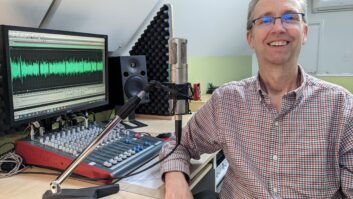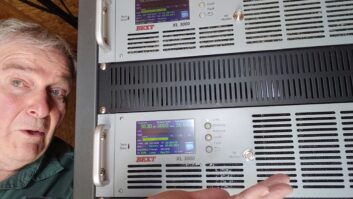(click thumbnail)Fig. 1: Summer may be over, but transmission line treats like this one don’t necessarily go away.Larry Schropp of Schropp Electronic Services was called in to work with Winston Hawkins, technical director for the Vernon Family Stations, on a KU satellite receiver problem. It seems that one station’s satellite receiver was dropping out periodically from 9 a.m. to 5 p.m. each day.
The receiver and LNB were replaced, but the problem persisted. Think on this puzzler and read on. We’ll see if you are right about what was causing this problem.
Just because summer is over (and, in much of the country, so are lightning storms), transmission line treats like the one in Fig. 1 don’t necessarily go away.
This burnout at Mark Bohnett’s WOLC in Princess Anne, Md., had nothing to do with good engineering practice gone wrong; Mark runs a first-class plant. But icy or wet weather and the absence of pressurization on lines or power foldback on transmitters need to be considered now.
As for Mark’s failure at the harmonic filter, one thing is for sure: It wasn’t due to a split or loose bullet. All the fingers were in place, as you can see in Fig. 2. Some of them broke off when the assembly was opened up, as expected. Sometimes insufficient support of rigid line can cause an internal failure.
Mark supported his line runs more than adequately; in fact, he’s adapted a rigid conduit support, as seen in Fig. 3. The plastic bushing holds the line firm, without deforming the outer conductor.
(click thumbnail)Fig. 2
I asked Mark where he got the “yellow” Kindorf that you see supporting the line section in Fig. 4. “From a can of paint,” he replied. Mark painted the steel Kindorf sections so they would stand out from the gray color of the steel ceiling.
The sections were painted before they were installed.
(click thumbnail)Fig. 3: Mark Bohnett supports his line runs with a rigid conduit system.
“This way, the support structure is more visible, and it’s less likely that someone would hit it with a ladder, or worse, their head or shoulder while working in the ceiling.”
Reach Mark via e-mail to [email protected]



. . .
Herm Reavis is executive vice president of the Mel Wheeler stations in Roanoke, Va. An avid Workbench reader — though he admits to being a non — engineering type – Herm has devoted 55 years to broadcasting.
As the cold weather approaches, Herm reflected on a past column about “Sterno and SpaghettiO’s,” in which we compiled a list of items to have at your transmitter site, just in case you are stormed in.
He draws on just as many years of hunting duck, goose and deer and suggests stashing away a box of crackers, a chunk of cheese and several cans of Vienna sausages, as well as bottled water. It could be a life-saver.
(click thumbnail)Fig. 4: Painted Kindorf stands out from the gray steel ceiling.
If you don’t have a small refrigerator at the transmitter site, spring for wax-sealed cheese; it will last longer. Keep the foodstuffs in a sealed plastic bin, so the mice aren’t tempted.
Herm adds one important necessity: toilet paper. You might also include a couple rolls of paper towels. As with road flares in the trunk of your car, you hope to never need this winter “care” package. Take a few moments to plan now.

. . .
When Larry Schropp first started his story about the satellite receiver failing, mentioned at the beginning of this column, I was sure it was birds or bees in the feedhorn of the LNB.
But he said the problem started at 9 a.m. and continued till 5 or 6 p.m. I scratched my head. Birds and bees typically are away from their nest during the day, returning at dusk. This was just the opposite.
With the help of Technical Director Winston Hawkins, they hooked up a spectrum analyzer and confirmed that the problem was TI – terrestrial interference. The next question was where this was coming from. The two engineers cobbled together an efficient “sniffer.”
Using a 100-watt inverter to supply AC power in a vehicle, they powered one of the KU satellite receivers. The RF input was fed through a splitter that provided a DC power pass for LNB power. The satellite receiver was only used to provide DC to the LNB. An LNB was connected to the DC feed port of the splitter. The analyzer then was connected to the DC block port, giving them a picture of what the LNB “saw.”
Driving in concentric circles around the field where the dish was located, they found the culprit: a station employee’s vehicle had a Cobra radar detector plugged into the cigarette lighter. In this vehicle, the lighter was powered even when the engine was turned off. The detector was spewing all kinds of trash, much of it received by the station satellite dish. The employee would arrive at work at 9 a.m., then stay until 5 or 6 p.m. When he left with his errant radar detector, the satellite system returned to normal.
The employee still has the radar detector, but it’s unplugged when he pulls into the station parking lot. All in a day’s work for some super-sleuth engineering detectives. Thanks to Winston and Larry for sharing their brainteaser and the methods they used to find the problem.












